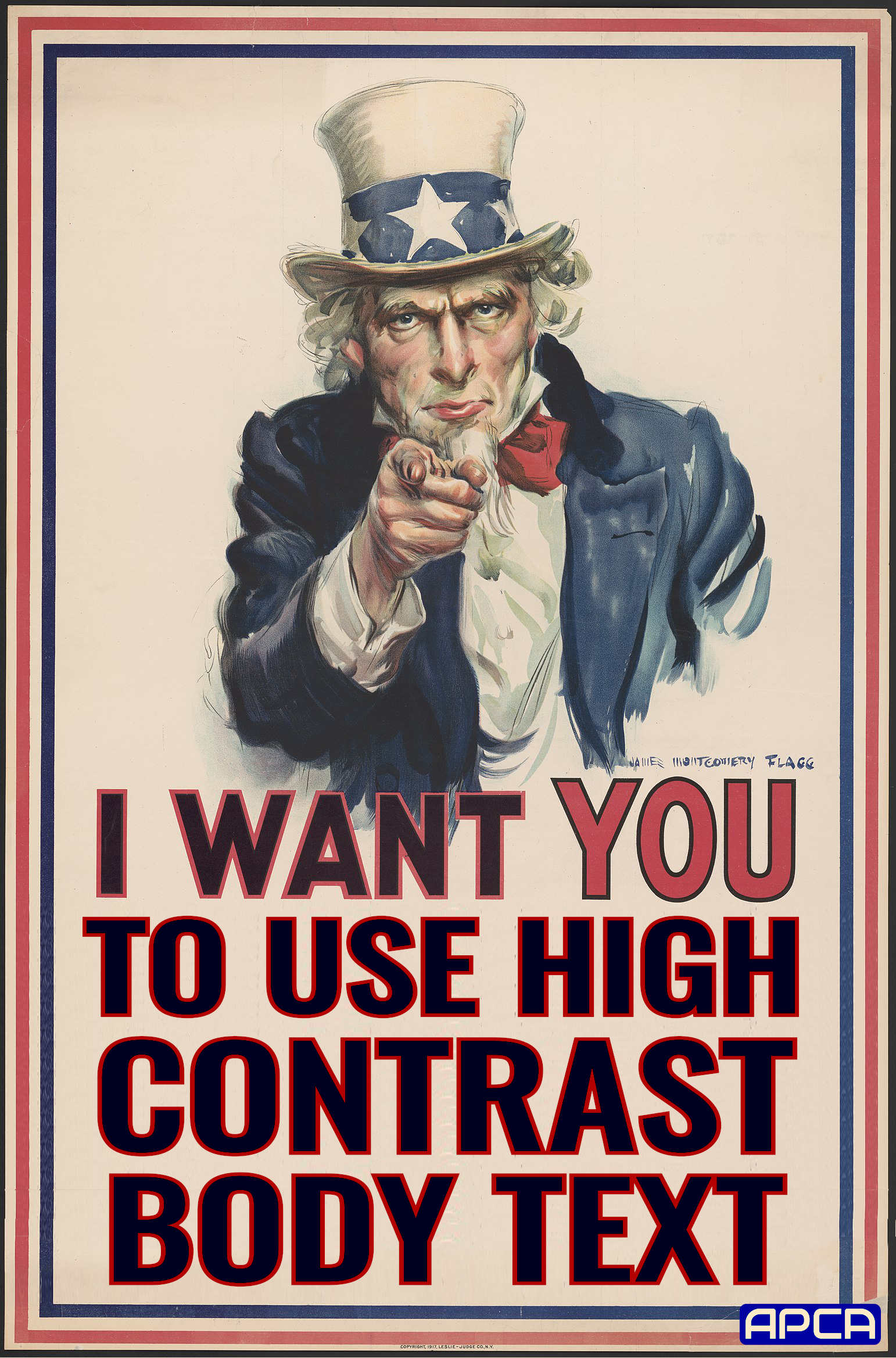APCA™ is the Accessible Perceptual Contrast Algorithm, a new way to predict contrast for text and non-text content on self-illuminated displays. This repository is for the documentation, for issue tracking, and for the discussion forum. The code, apps, variants, and supporting libraries, are in separate repos.
These are intended for end users, and those interested in a plain language overview without a lot of the math & theory.
- Easy Intro to APCA? A plain-language introduction to perceptually uniform contrast.
- Bronze Simple Mode A "most basic" design guideline, intended for users migrating from WCAG 2 contrast.
- APCA™ Linktree Brief curated link collection—an ideal starting point.
- APCA™ Catalog of Resources, Articles, & Links Large main catalog of articles, repos, white papers, and more!
- Main Readme Doc This page includes a discussion of the math, code walkthroughs, and links to developer related goodies. If you'd like to dive into the deep end, you could jump in here—but deep waters can be murky...
- Why APCA? A basic overview at the shallow end of the pool.
- APCA in a nutshell An early minimum user guide, largely superceeded by APC-RC
- APCA FAQ Frequently Asked Questions (work in progress)
- The draft independent APCA Readability Criterion is up as a work in progress, still sections to be added and/or adjusted.
- Direct links to subpages:
- Bronze Simple Mode A "most basic" design guideline, intended for users migrating from WCAG 2 contrast.
- Visual Readability Contrast The multi-level conform guideline: Bronze, Silver, Gold, for basic to enhanced accessibility.
- Non Text Contrast PLACEHOLDER for the non-text guidelines (coming soon!)
- Design Guide: Visual Contrast Practical design advice with examples.
- Design Guide: Paper Reading Experience (Work in progress) Guidelines for a reduced-fatigue design for light mode.
- Design Guide: Non Text Contrast PLACEHOLDER Practical design advice with examples.
For comments or questions see the SAPC-APCA forum here, please post all comments, questions, or discussions regarding theory, math, code, third-party tools, etc., here and not in the satellite repositories, so they can be tracked and resolved. Discussion here may eventually become part of the FAQ and guidelines.
- Color and Contrast Tools Listing Many third party tools, as well as canonical technology demonstrators.
- apca-w3 This satellite repository is the approved code intended for public guidelines, and is the only code that should be used for any development purpose.
- The code is also available as a package at
npm i apca-w3
Maths! Vision Science! Photons on Parade!
- The base APCA-W3 formula in LaTeX math for your viewing and calculating pleasure.
- The Realities And Myths Of Contrast And Color color and contrast feature article at Smashing Magazine.
- Peer Review and Third Party Analysis APCA and APC-RC are derived from decades of peer-reviewed science.
- Regarding Exponents Is delta-gamma some kinda frat house? Nope... It's math.
- Standard Observer Model The setting for a mathematical eyeball.
- Visual Contrast Draft Whitepaper Almost as tasty as a draft beer! This is a very early white-paper draft as part of the Visual Contrast group of Silver/WCAG 3. Here for historical reasons, the above links such as "Why APCA" provide a clearer understanding.
- Myndex Research on Twitter/X
- Inclusive Reading Technologies on Twitter/X
- Myndex on Mastodon
- Myndex on Linkedin
- Myndex on Stack Overflow
- Myndex Gists on GitHub
- TangledWeb.xyz related tech blog
- Why APCA: A brief plain language overview of APCA and readability contrast.
- Peer and Third Party Review: APCA and APC-RC in real world testing and review.
- APCA in a Nutshell: Quick overview of levels, use cases, and font sizing.
- APCA Main Documentation (READ ME): The repo basic readme file for an overview and quickstart.
- APCA Documentation Index: An index of relevant APCA documentation.
- APCA Formula 0.9.98g4g: LaTeX of the APCA formula.
- Repo List: A list of specific versions of APCA, Bridge PCA, and support libraries.
- Standard Observer Model: Draft Standard Observer.
- Important Change Notices: General Change History (see individual repos for specifics)
- Regarding Exponents: Notes on the exponents used in APCA.
- Accessibility Statement: A statement for beta testers and early adopters to use place on sites using APCA
- APCA Minimum Compliance for Developers: Standards for what can be called APCA™.
- APCA FAQ: Just starting, so few Q/A yet.
You are here 🎯 this index page is served at the github APCA documentation repo.
Over there is the APCA W3 version, and it's the same as the published npm package "apca-w3".
The BridgePCA is backwards compatible with WCAG 2, and it's the same as the published npm package "bridge-pca".
ColorParsley is a micro library for auto parsing color strings of all kinds, also on npm.
SeeStars is a micro library for creating CIE Lstar
DeltaPhiStar is an ultra simple general purpose contrast equation.
The canonical demo tool at Myndex
Try out the Bridge PCA tool at Myndex
Color insensitive vision simulation (aka colorblind). Includes deuteranopia, protanopia, tritanopia, and blue cone monochromacy/achromatopsia.
IRT is a California nonprofit, dedicated to developing tecnologies to improve visual accessibility for all, and home to the APCA Readability Criterion.
The APCA base color-pair formula, in math notation. 0.0.98G-4g
























